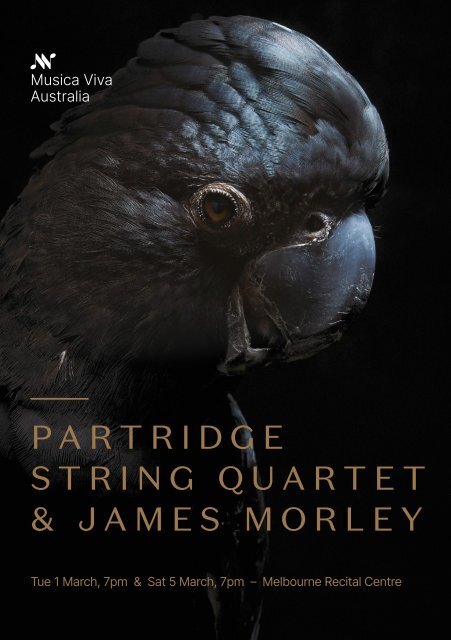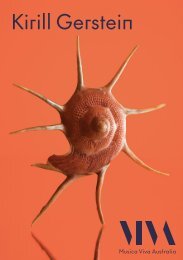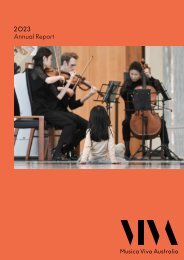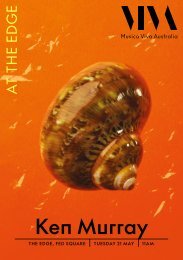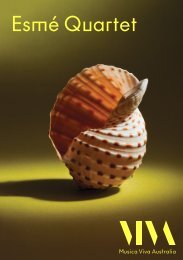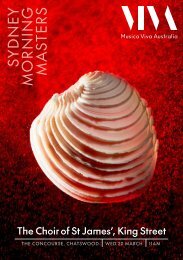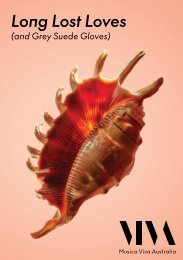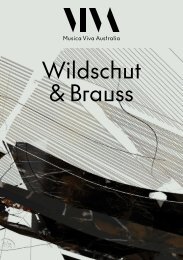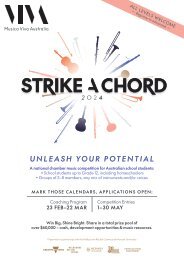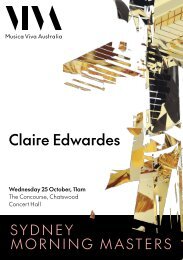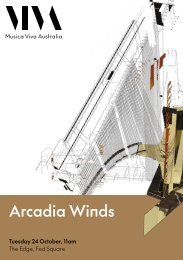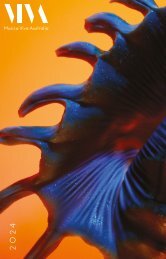Partridge String Quartet & James Morley Program Guide | March 2022
Create successful ePaper yourself
Turn your PDF publications into a flip-book with our unique Google optimized e-Paper software.
—<br />
PARTRIDGE<br />
STRING QUARTET<br />
& JAMES MORLEY<br />
Tue 1 <strong>March</strong>, 7pm & Sat 5 <strong>March</strong>, 7pm – Melbourne Recital Centre
2
Musica Viva Australia acknowledges the Traditional Custodians of the many lands on<br />
which we meet, work, and live, and we pay our respects to Elders past and present –<br />
people who have sung their songs, danced their dances and told their stories<br />
on these lands for thousands of generations, and who continue to do so.<br />
PROGRAM<br />
Holly HARRISON (b. 1988)<br />
Balderdash (2018)<br />
15 min<br />
Franz SCHUBERT (1797-1828)<br />
<strong>String</strong> Quintet in C major, D. 956 (1828)<br />
I Allegro ma non troppo<br />
II Adagio<br />
III Scherzo. Presto – Trio. Andante sostenuto<br />
IV Allegretto<br />
50 min<br />
|<br />
3<br />
|<br />
Mana Ohashi<br />
Jos Jonker<br />
Eunise Cheng<br />
Daniel Smith<br />
violin<br />
guest violin<br />
viola<br />
cello<br />
Meet the Artists<br />
after the concert<br />
on 1 <strong>March</strong>.<br />
<strong>James</strong> <strong>Morley</strong><br />
cello<br />
With special thanks to the Producers’ Circle and the Amadeus Society<br />
for their support of the <strong>2022</strong> Concert Season, and to our Concert Champions<br />
the Musica Viva Victorian Committee and The Continuo Collective Syndicate.
ABOUT THE ARTISTS<br />
<strong>Partridge</strong> <strong>String</strong> <strong>Quartet</strong><br />
|<br />
4<br />
|<br />
As Musica Viva Australia’s 2020–<strong>2022</strong><br />
FutureMaker artists, the award-winning<br />
<strong>Partridge</strong> <strong>String</strong> <strong>Quartet</strong> are fast becoming<br />
a force within the Australian classical<br />
music scene as one of the leading string<br />
quartets of its generation. Brilliant and<br />
dynamic chamber musicians, the quartet<br />
strives to connect and surprise audiences<br />
through their vibrant performances and<br />
creative collaborations.<br />
Formed at the Australian National<br />
Academy of Music, the quartet received<br />
national recognition as first prize winners<br />
of the inaugural Queensland International<br />
Chamber Music Competition (2019) and<br />
ANAM Chamber Music Competition<br />
(2018). In 2018, the quartet were recipients<br />
of the Husky Energy Artist Award after<br />
they were selected as one of 10 string<br />
quartets internationally for a string quartet<br />
program residency at the Banff Centre<br />
of Arts and Creativity in Canada where<br />
they were mentored by music faculty from<br />
Harvard and Julliard, the JACK <strong>Quartet</strong>,<br />
Eybler <strong>Quartet</strong>, Parker <strong>Quartet</strong> and prolific<br />
American composer Paul Wiancko.<br />
Throughout their studies, the quartet<br />
received tutelage and mentoring from<br />
the music faculty of ANAM and members<br />
from the Dover <strong>Quartet</strong>, Australian <strong>String</strong><br />
<strong>Quartet</strong>, Borodin <strong>String</strong> <strong>Quartet</strong>, Trio Dali<br />
and Alban Berg <strong>Quartet</strong>.<br />
The quartet has performed alongside<br />
highly recognized Australian and<br />
international chamber musicians nationally<br />
and featured on ABC Classic, Violin<br />
Channel, CutCommon and Limelight<br />
Magazines. Passionate advocates of<br />
Australian composers, <strong>Partridge</strong> performed<br />
an entire five string quartet cycle by<br />
Richard Mills AM and were recipients of<br />
the Musica Viva Chamber Music Prize<br />
for their performance of Paul Stanhope’s<br />
Second <strong>Quartet</strong>. They have presented<br />
collections of Australian works at the<br />
MPavilion, National Gallery of Victoria,<br />
Ian Potter Centre and National Film and<br />
Sound Archive Theatre in Canberra and<br />
are engaged in exciting projects and music<br />
festivals in the upcoming future.
© Alan Weedon<br />
<strong>James</strong> <strong>Morley</strong> cello<br />
<strong>James</strong> <strong>Morley</strong> is currently based in<br />
Melbourne, having recently completed<br />
studies with Howard Penny at the<br />
Australian National Academy of Music<br />
(ANAM), where he received numerous<br />
accolades. He has also studied in Sydney<br />
with Julian Smiles, and Adelaide with<br />
Rachel Johnston, Janis Laurs, and Hilary<br />
Kleinig.<br />
<strong>James</strong>’ work incorporates a wide array of<br />
styles and influences. He has performed<br />
concertos with Tasmanian Symphony<br />
Orchestra, Ensemble Apex, Sydney<br />
Youth Wind Orchestra, and Adelaide<br />
Youth Orchestra. In 2019 <strong>James</strong> was the<br />
Australian Chamber Orchestra Emerging<br />
Artist for cello and was a finalist for the<br />
2020 Freedman Fellowship. He will be<br />
giving his UKARIA solo debut for Adelaide<br />
Festival this year, as well as performing<br />
for Tempo Rubato, Melbourne Chamber<br />
Orchestra and Wilma & Friends.<br />
<strong>James</strong>’ career is also very new music<br />
oriented, and solo premieres include<br />
compositions by the likes of Liza Lim,<br />
Johannes MacDonald and Josephine<br />
Macken. He is also a member of<br />
Rathdowne <strong>Quartet</strong> and performs chamber<br />
music regularly, often collaborating with<br />
Penny and <strong>Partridge</strong> <strong>Quartet</strong>s.<br />
|<br />
5<br />
|<br />
Musica Viva Australia: Making Australia a more musical place<br />
At Musica Viva Australia, we’re proud to be<br />
one of the world’s leading presenters of<br />
chamber music. Passionate about creating<br />
a vibrant musical future for Australia’s artists<br />
and audiences, we feel fortunate to nurture<br />
both established and emerging talent from<br />
around the country. We’re also committed<br />
to learning from our First Nations friends<br />
and colleagues how to most effectively<br />
include in our work the many peoples and<br />
languages that, together, comprise the<br />
oldest living culture in the world.<br />
Musica Viva Australia is committed to the<br />
future of classical music, and to being at<br />
the forefront of its evolution. Our dedication<br />
to the commissioning and programming<br />
of new Australian works is key to our<br />
vision, and through eclectic and thoughtful<br />
programming, we endeavour to lead<br />
the industry in presenting concerts that<br />
challenge and thrill all audiences.
ABOUT THE MUSIC<br />
|<br />
6<br />
|<br />
Holly Harrison writes:<br />
Balderdash begins and ends with amplifier<br />
feedback: a sound that quickly makes us<br />
bring our fingers to our ears! The piece<br />
imagines an alternate world in which music<br />
is heard between the feedback – a sort of<br />
sub/hyper-sonic sound world which takes<br />
place in mere seconds.<br />
With this in mind, the string quartet<br />
explores musical ideas inspired by electric<br />
guitar, including distortion, white noise,<br />
whammy bars, power-chords, dive-bombs,<br />
wah-wah, phaser effects, slap bass, and<br />
of course, speaker feedback. Balderdash<br />
makes high use of punk rock rhythms,<br />
dissonance, and percussive-based jams,<br />
which morph in and out of bluegrass,<br />
grunge, prog-rock, metal, and… disco.<br />
Given the piece was commissioned for<br />
a competition, I felt it might be fun to<br />
experiment with a battle-of-the-bands<br />
theme within the string quartet itself.<br />
Throughout Balderdash, players go rogue<br />
(especially the cello!), engage in oneupmanship,<br />
jam, duel, challenge, compete,<br />
interrupt, surrender, work together in<br />
teams, and cooperate as one. The piece is<br />
intended to be theatrical and encourages<br />
the quartet to perform with abandon.<br />
© HOLLY HARRISON<br />
Balderdash was commissioned for the<br />
2018 Melbourne International Chamber Music<br />
Competition, through the support of the<br />
Silo Collective.<br />
Schubert lived a life which seemed<br />
mostly dedicated to having a good time<br />
with his friends whenever possible; but<br />
he worked very hard too, turning out<br />
symphonies, chamber music, piano music,<br />
10 resoundingly unsuccessful operas<br />
and 600 of the best songs ever written.<br />
Standing five feet one inch tall in shoes,<br />
balding, bespectacled and with the<br />
unprepossessing nicknames ‘Mushroom’<br />
or ‘Fatso’, he yet had a passionate soul and<br />
was unafraid to reveal it in his music.<br />
Sadly, by 1828 the Bohemian life had<br />
caught up with the rollicking young man<br />
of the Schubertiade parties. Syphilis ruled<br />
out the marriage-and-kids phase his<br />
social circle was settling into, so he went<br />
looking for a different kind of stability: he<br />
seemed to be thinking about getting a<br />
church job, and signed up for lessons with<br />
court organist Simon Sechter to improve<br />
his counterpoint. This may seem unduly<br />
modest in someone who’d just completed<br />
two piano trios, three magnificent piano<br />
sonatas, Winterreise and this Quintet, but<br />
Schubert was a pragmatic artist – a fact<br />
which should be borne in mind regarding<br />
this work.<br />
It’s too easy, with hindsight, to see it as the<br />
last, dying, heavenward-looking statement<br />
of a tragic composer. However, there are<br />
many of Schubert’s songs from years<br />
before with a similar gamut of expression,<br />
and most of the evidence suggests that<br />
although he was aware of the possibility<br />
of death (difficult not to be, in a time when<br />
you were lucky to reach 50) the Quintet<br />
was written with no particular sense of<br />
foreboding.<br />
Very little is, however, known about why<br />
it was composed, and for whom. There<br />
are no extant sketches nor manuscript<br />
copy. It wasn’t performed in public until<br />
1850 (in a Viennese concert led by the<br />
son of one of the composer’s classmates),<br />
and not published until 1853. One theory
suggests that he intended to supply a<br />
publisher with a C major quintet – with the<br />
successful quintets in that key by Mozart<br />
and Beethoven in mind.<br />
Unlike those works, however, Schubert<br />
opted for an instrumental line-up which<br />
included two cellos rather than two<br />
violas. This has obvious benefits in terms<br />
of depth of sound, richness, volume<br />
and mellowness; but it also, tellingly,<br />
frees up the viola. This was Schubert’s<br />
own preferred instrument when playing<br />
chamber music, and it’s fascinating to<br />
hear the viola’s chameleon role, first taking<br />
sides with the violins, and then joining the<br />
cellos. The viola often seems to act as a<br />
harmonic pivot, sitting unobtrusively in the<br />
centre of things but influencing the group’s<br />
entire colour.<br />
The first movement sets up a wealth of<br />
thematic invention and contrasts of light<br />
and shade. The opening motif, and the<br />
subsequent lyrical theme, triplets and<br />
pizzicato gestures, create the basic toolkit<br />
that Schubert uses to build a substantial<br />
sonata form structure.<br />
The Adagio second movement is exquisite.<br />
Pianist Arthur Rubinstein wanted it at his<br />
funeral. Cellist Alfredo Piatti requested<br />
it for a death-bed-side performance to<br />
ease him out of the world. Countless<br />
performers and music lovers have turned<br />
to it for inspiration or consolation. So how<br />
did Schubert do it? In part, it is the old<br />
trick of keeping it simple. The solo violin<br />
holds the main interest, in an ethereal,<br />
dotted-rhythm theme; the harmony of<br />
the inner parts floats timelessly as a hazy<br />
background; and the lower cello keeps<br />
things moving with a steady, honest<br />
pizzicato. With a violent unison trill,<br />
suddenly everything changes: the middle<br />
section has a more openly passionate feel,<br />
with greater complexity of harmony and<br />
texture. The shift from E major to distant<br />
F minor is dramatic enough. Add to it<br />
sweeping lyricism and extreme dynamic<br />
range, and the result is as shocking as a<br />
thunderstorm on an otherwise clear day,<br />
before the relief of a return to major-key<br />
serenity and a decorated, filigree version<br />
of the opening section.<br />
As if to confound all those who liked to<br />
read a presentiment of death into the slow<br />
movement, the Scherzo is cheerfulness<br />
itself, stomping along in a country dance.<br />
The Andante sostenuto of the Trio section<br />
admittedly seems quite tragic, returning<br />
to shadows of long sustained notes,<br />
and adding a sorrowful downward scale<br />
pattern – but the irrepressible Scherzo<br />
comes thundering out of the dark corners<br />
and bursts into a reprise.<br />
The Finale perhaps drew from the<br />
experience of both Haydn and Beethoven<br />
in adapting ‘folk music’ colours. The rustic<br />
quality of the first theme is countered<br />
by an entirely Viennese second theme,<br />
lyrical and graceful. There is a third sort of<br />
theme too, more a reminiscence of the first<br />
movement than a proper entity in itself.<br />
A racing, rhythmic coda brings to a close<br />
Schubert’s last, longest, and arguably<br />
greatest chamber work.<br />
ADAPTED FROM A NOTE<br />
BY KP KEMP © 2017<br />
|<br />
7<br />
|
We’ve been taking orders and delivering fine<br />
wines to homes all across Australia since 1974.<br />
You won’t find our wine in bottle shops - we’ve<br />
always preferred to cut out the middle man.<br />
If you’re in Mudgee, come and see us at our<br />
beautiful winery and vineyard, try our wines<br />
and enjoy delicious local produce and weekend<br />
lunches in the gardens and grounds.<br />
As a friend of Musica Viva Australia, you are a<br />
friend of ours too, so take 20% off your first<br />
Huntington Estate order with coupon code<br />
MVAFRIEND, online or in our charming Cellar<br />
Door.<br />
641 ULAN ROAD BUCKAROO NSW 2850<br />
WWW.HUNTINGTONESTATE.COM.AU<br />
Journey into the Chamber of Musical Curiosities<br />
Hosted by Artistic Director Paul Kildea, the Chamber of<br />
Musical Curiosities is a podcast exploring the world of music<br />
in and around Musica Viva Australia. During the episodes,<br />
guests reflect upon creativity, their careers, and their passion<br />
for chamber music.<br />
Episode 10: Kim Williams<br />
In this episode, Kim discusses the various careers he’s had<br />
throughout his remarkable life. They explore the importance<br />
of Australian musicians, composers and learning the history of<br />
Australian music culture and musical traditions. Paul and Kim<br />
also have a heartfelt reflection on their mutual friend Richard<br />
Gill and his advocacy for music education in Australia.<br />
Listen on Spotify, Apple Podcasts or our website<br />
to come with us inside the Chamber of Musical<br />
Curiosities and explore a collection of musical<br />
marvels.<br />
musicaviva.com.au/podcast
Music brings us together<br />
At Musica Viva Australia we are proud to share<br />
exceptional music with audiences of every age,<br />
location and circumstance — it’s what we have<br />
always done, and what we will always strive to do.<br />
With your contribution, we can support our<br />
professional musicians, introduce children to<br />
live music in schools, commission new works,<br />
create innovative and engaging online content,<br />
and develop future generations of artists.<br />
Scan the QR code to give today.<br />
Contact us on philanthropy@musicaviva.com.au<br />
Melbourne’s Finest<br />
Afternoon Tea Experience<br />
Discover The Langham Afternoon Tea at Aria Bar & Lounge and<br />
indulge in a selection of British tea time classics with a modern twist.<br />
#LovingLangham #CelebrateTheEveryday<br />
1 Southgate Avenue, Southbank, Vic 3006 Australia<br />
T (61) 8696 8888 F (61) 9690 5889<br />
langhamhotels.com/melbourne
VIC SUPPORTERS<br />
|<br />
10<br />
|<br />
CUSTODIANS<br />
Elizabeth & Anthony Brookes, Julian Burnside AO QC,<br />
Ms Helen Dick, Robert Gibbs & Tony Wildman, Helen<br />
Vorrath, Anonymous (8)<br />
LEGACY DONORS<br />
The late Raymond Brooks, In memory of Anita<br />
Morawetz, The family of the late Paul Morawetz, The<br />
late Dr G D Watson<br />
ENSEMBLE PATRONS<br />
Our artistic vision for <strong>2022</strong> is made possible thanks to<br />
the extraordinary generosity of our Ensemble Patrons,<br />
each of whom supports the presentation of an entire<br />
national tour for our <strong>2022</strong> Season.<br />
Ian Dickson & Reg Holloway (Van Diemen’s Band)<br />
Anonymous (Paul Grabowsky & Andrea Lam)<br />
Peter Griffin AM & Terry Swann<br />
as part of The Travellers - Giving Circle<br />
(A Winter’s Journey)<br />
Australian Music Foundation (Z.E.N. Trio)<br />
Eleanore Goodridge OAM<br />
(Avi Avital & Giovanni Sollima)<br />
CONCERT CHAMPIONS<br />
The mainstage concerts of our <strong>2022</strong> Season are<br />
brought to life thanks to the generosity of our<br />
Concert Champions around the country.<br />
Alexandra Clemens, Continuo Syndicate, Monica Lim<br />
& Konfir Kabo, Peter Griffin AM & Terry Swann, Peter<br />
Lovell, Rosemary & John MacLeod, The Morawetz<br />
Family in memory of Paul Morawetz, Greg Shalit &<br />
Miriam Faine (2), Dr Michael Troy, The Musica Viva<br />
Victorian Committee<br />
PRODUCERS’ CIRCLE<br />
Darin-Cooper Family Foundation<br />
AMADEUS SOCIETY<br />
The Amadeus Society is a group of passionate music<br />
lovers and advocates in Sydney and Melbourne who<br />
have joined together to support the extraordinary<br />
artistic initiatives of Musica Viva Australia.<br />
Marc Besen AC & Eva Besen AO, Dr Di Bresciani OAM,<br />
Julian Burnside AO QC (President) & Kate Durham,<br />
Peter Griffin AM & Terry Swann, Penelope Hughes,<br />
Dr Alastair Jackson AM, Andrew Johnston,<br />
Prof. John Rickard<br />
MASTERCLASSES<br />
GIVING CIRCLE<br />
The Masterclasses Giving Circle is a group of generous<br />
donors whose collective support will enable the artistic<br />
development of the next generation of Australian<br />
chamber musicians.<br />
Nicholas Callinan AO & Elizabeth Callinan, Caroline &<br />
Robert Clemente, Ian & Caroline Frazer, Allan Myers<br />
AC QC & Maria Myers AC, Patricia H. Reid Endowment<br />
Fund, Andrew Sisson AO & Tracey Sisson, Mick &<br />
Margaret Toller, Anonymous (2)<br />
COMMISSIONS<br />
Musica Viva Australia acknowledges and celebrates<br />
those individuals and collectives who have generously<br />
committed to commissioning new music in <strong>2022</strong>/23 to<br />
be enjoyed by us all.<br />
In loving memory of Jennifer Bates; Julian Burnside<br />
AO QC & Kate Durham; The Barry Jones Birthday<br />
Commission; Michael & Fréderique Katz, in honour of<br />
Cecily Katz; Graham Lovelock & Steve Singer;<br />
DR & KM Magarey; Vicki Olsson; Tribe family in honour<br />
of Doug Tribe’s 75th birthday<br />
Musica Viva Australia also thanks the Silo Collective,<br />
the Ken Tribe Fund for Australian Composition, and<br />
the Hildegard Project for their support in bringing new<br />
Australian works to life.<br />
MAJOR GIFTS<br />
$20,000-$49,999<br />
The Morawetz Family in memory of Paul Morawetz,<br />
Marjorie Nicholas OAM, Anonymous<br />
$10,000-$19,999<br />
Roger Druce & Jane Bentley, Mercer Family Foundation,<br />
Lyn & David Munro - in memory of Sylvie Trobe,<br />
Greg Shalit & Miriam Faine, Anonymous<br />
$5,000-$9,999<br />
Dr Di Bresciani OAM & Lino Bresciani, Alastair &<br />
Sue Campbell, Alexandra Clemens, In Memory of<br />
Kate Boyce, Robert Gibbs & Tony Wildman, Stephen<br />
Shanasy, Anonymous<br />
ANNUAL GIVING<br />
$2,500-$4,999<br />
Jan Begg, Anne Frankenberg & Adrian McEniery,<br />
Lyndsey & Peter Hawkins, Doug Hooley, Ralph & Ruth<br />
Renard, Maria Sola, Gai & David Taylor, Helen Vorrath,<br />
Lyn Williams<br />
We sincerely appreciate the<br />
generous support we receive from<br />
our incredible community, and<br />
encourage you to scan the QR code<br />
to see a full list of donors over $500<br />
to Musica Viva Australia.<br />
We thank all our audience members who donated the<br />
value of their cancelled tickets towards the Artist Fund.
PARTNERS<br />
Perth Concert Series<br />
Sydney Morning Masters Series<br />
Law Firm<br />
Chartered Accountants<br />
Piano & Tuning<br />
Media<br />
|<br />
11<br />
|<br />
Wines<br />
Hotels<br />
National Government<br />
Musica Viva Australia is a not-for-profit organisation endorsed<br />
by the Australian Taxation Office as a Deductible Gift Recipient<br />
and registered with the Australian Charities and Not-for-profits<br />
Commission (ACNC).
2<br />
V<br />
0<br />
I<br />
2<br />
V<br />
2<br />
A<br />
VAN DIEMEN’S BAND<br />
Touring: 26 April–14 May<br />
musicaviva.com.au/van-diemens-band | 1800 688 482<br />
—<br />
Australia’s finest early music specialists invite you to experience<br />
the beautiful melding of cultures in Europe’s historical borderlands.<br />
—<br />
With special thanks to our Ensemble Patrons Ian Dickson & Reg Holloway.


